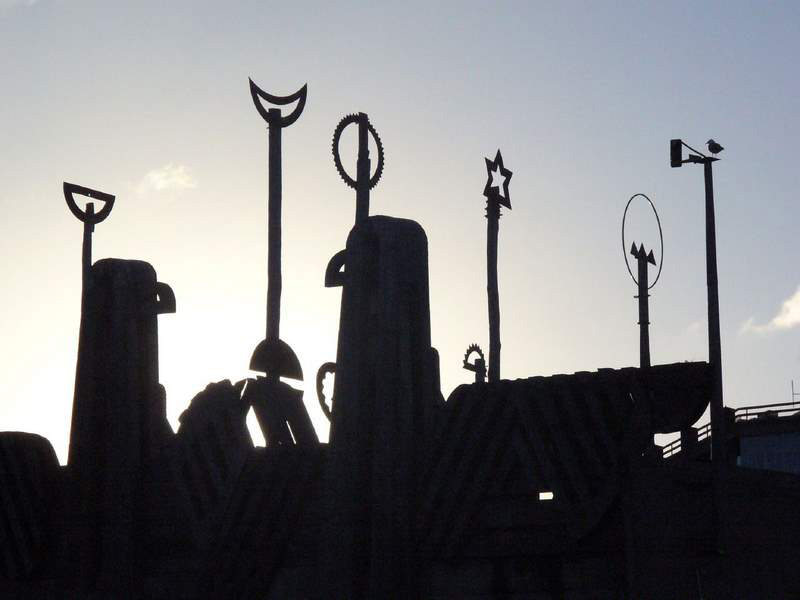
Original image by David Leverton
City to Sea Bridge
| Artist | Para Matchitt, John Gray, Rewi Thompson |
|---|---|
| Year | |
| Location | Connecting Civic Square to the waterfront, over Jervois Quay |
| Tour directions | Tour starts here |
Did you know?
Wellington harbour is said to once have been a great lake inhabited by two taniwha. The taniwha tried to reach the ocean and crashed through the land, transforming the lake into a harbour.
Sculpture background
The collaborative work City to Sea Bridge opened in 1994. It connects the heart of the city to Frank Kitts lagoon and the waterfront, stretching over Jervois Quay, a multi-laned road that separates the city from the waterfront.
The bridge is constructed of timber planking and is adorned with non-traditional wooden sculptures carved by prominent Māori artist Paratene Matchitt, some of which form the sides of the bridge. One one side of bridge there are two taniwha called Ngake and Whātaitai. On the other side are two manu (birds).Other sculptures are whales, patiki (flounder), and fish.
Some sculptures are on metal poles, including a star and the phases of the moon, which were inspired by a flag used by Te Kooti (a Māori military leader and prophet). These sculptures are best viewed on clear evenings with the full moon rising behind them.
The City to Sea Bridge and its neighbour, Te Aho a Māui together explore the Māori creation story of Te Whanganui-a-Tara (Wellington Harbour) and of Te Aho a Māui (Māui's fishing line), which he used to fish up the North Island of New Zealand.
The bridge provides 'a physical and conceptual space through which the different cultural uses and meanings invested in Te Whanganui-a-Tara or Wellington Harbour are played out... [and] signals the increasing prominence granted to Māori culture within the realm of public art' (Harper & Lister, 2007, pp. 16-18).
- City to Sea Bridge Para Matchitt, John Gray, Rewi Thompson 1992 -41.28871249 174.7785641 /__data/assets/image/0019/1765/thumb-city-to-sea-bridge.jpg City to Sea Bridge /tours/civic-square/city-to-sea-bridge
- The Rugby World Cup Celebration Weta Workshop 2011 -41.288575 174.778189 /__data/assets/image/0003/1659/thumb-the-rugby-world-cup-celebration.jpg The Rugby World Cup Celebration /tours/civic-square/the-rugby-world-cup-celebration-sculpture
- The Pool Charlotte Fisher 1994 -41.2889891 174.7782308 /__data/assets/image/0020/1658/thumb-the-pool.jpg The Pool /tours/civic-square/the-pool
- Te Aho a Māui Rewi Thompson 1991 -41.288906 174.778100 /__data/assets/image/0004/1768/thumb-te-aho-a-maui.jpg Te Aho a Māui /tours/civic-square/te-aho-a-mui
- Nikau Ian Athfield 1991 -41.28898896 174.777868 /__data/assets/image/0005/1769/thumb-nikau-palms.jpg Nikau palms /tours/civic-square/nikau-palms
- Anchor Stone Ra Vincent 2004 -41.28912996 174.7776281 /__data/assets/image/0014/1652/thumb-anchor-stone.jpg Anchor Stone /tours/civic-square/anchor-stone
- Pig Alan Hobbs 1995 -41.28903118 174.7775287 /__data/assets/image/0016/1654/thumb-pig.jpg Pig /tours/civic-square/the-pig
- Prow and Capital Matt Pine 1991 -41.28877964 174.777552 /__data/assets/image/0017/1655/thumb-prow-and-capital.jpg Prow and Capital /tours/civic-square/prow-and-capital
- Ferns Neil Dawson 1998 -41.2887753 174.77721 /__data/assets/image/0020/1766/thumb-fern.jpg Fern /tours/civic-square/ferns
- Fault Ralph Hotere and Bill Culberth 1994 -41.28856 174.77724 /__data/assets/image/0014/1904/thumb-fault.jpg Fault /tours/civic-square/fault
- Seven Steps to Heaven Mary-Louise Brown 2000 -41.28885063 174.7767735 /__data/assets/image/0018/1656/thumb-seven-steps-to-heaven..jpg Seven Steps To Heven /tours/civic-square/seven-steps-to-heaven
- Silent People Chris Booth 1991 -41.28860247 174.7766809 /__data/assets/image/0019/1657/thumb-silent-people.jpg Silent People /tours/civic-square/silent-people
- Grand Head Terry Stringer 1986 -41.28908086 174.775988 /__data/assets/image/0015/1653/thumb-grand-head.jpg Grand Head /tours/civic-square/grand-head

